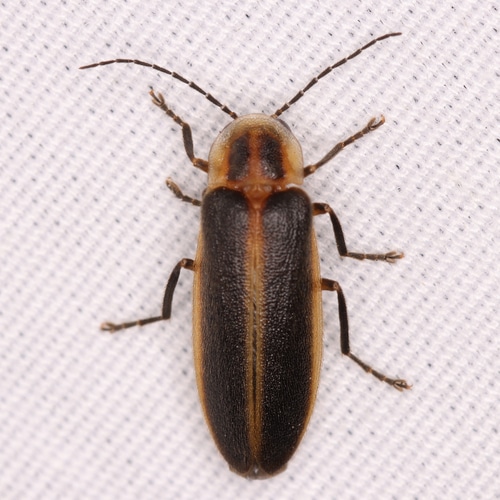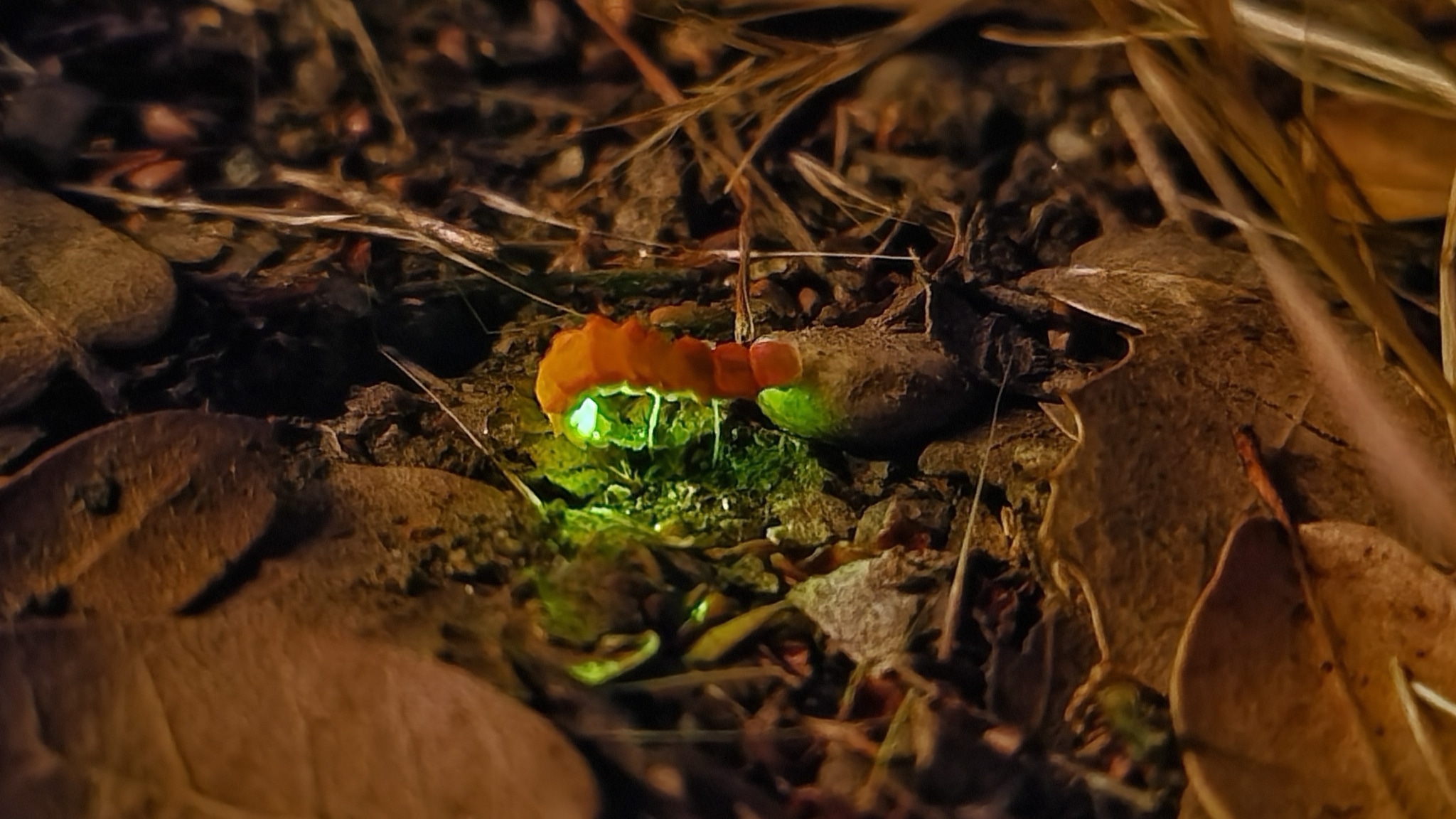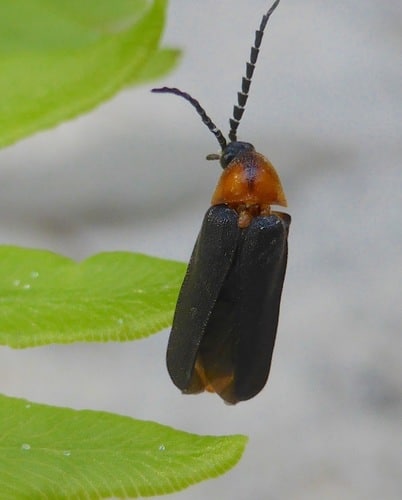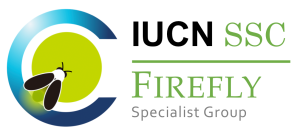How do we protect firefly populations while also achieving other ecological goals on the landscape? This is a question that land managers grapple with when figuring out how to maintain the wildlife habitats they steward.
Prescribed fire, also known as controlled burns or cultural fire, is the intentional use of fire to sustain or regenerate natural habitats. In the United States, these habitats include prairies, oak woodlands, longleaf pine savannahs, heathlands, and others. Fire reduces fuel loads, encourages regrowth of certain species, and alters soil chemistry, making some nutrients more available to plants.


LINK: Image
LINK: CC BY 2.0
No formal scientific studies have directly examined the short-term or long-term impacts of fire on firefly populations, but an understanding of firefly natural history, anecdotal observations from places shaped by fire, and studies on other groups of invertebrates all help to guide decision making.
How might fire hurt fireflies?
In places like South Carolina, Georgia, and Texas, firefly surveyors have stood at the edge of prescribed burn units and made a striking observation: unburned habitat was full of firefly activity while the recently burned areas were largely devoid of fireflies. It is hard to draw firm conclusions from these anecdotal observations, but we know of several mechanisms by which fire can negatively impact fireflies.
Fire can kill fireflies and reduce their survival.
The most obvious way that fire can harm fireflies is by directly burning firefly larvae, pupae, or adults. The life stages most vulnerable to fire are likely larvae and pupae, both because many prescribed fires happen in the fall, winter or spring, when fireflies are in their larval stage, and because larvae and pupae cannot fly away like winged adults can.
For example, the late firefly expert Dr. James Lloyd speculated that springtime prescribed burns in Florida could be reducing Pyractomena populations by destroying pupae on the lower parts of tree trunks and plant stems.
Fireflies may also die in the aftermath of fires due to drier conditions and loss of shelter, like leaf litter and fallen logs.


LINK: Image
LINK: CC BY-NC
Fire can impact the species that fireflies eat.
Even in cases where fire does not directly kill fireflies, it may reduce the populations of the invertebrates that they feed upon. Fire impacts on snails (a major food source for many firefly species) may be a helpful proxy for fire impacts on fireflies. While the impacts vary by species, fire often tends to reduce the abundance and diversity of snails. Fire can kill snails directly, but it also lowers snail populations by creating drier conditions.


LINK: Image
LINK: CC BY-NC
Not all fireflies are affected equally.
The consequences of catastrophic wildfires that burned in the Great Smoky Mountains in 2016 provide both a cautionary tale about the dangers of intense fire to fireflies and a case study of how different types of fireflies are impacted. During a severe drought, human-caused fires spread rapidly, burning over 17,000 acres and causing the loss of lives, structures, and forest.
The following seasons, Tennessee resident and firefly expert Lynn Faust noticed that some firefly populations were depressed, but that recovery varied by genus. Photinus fireflies, whose larvae live deeper in the soil, seemed to bounce back faster than fireflies in the Photuris and Pyractomena groups, which forage in the leaf litter and on the surface of the forest floor. The microhabitats that fireflies use during their life cycle influence their response to fire.


LINK: Image
LINK: FireflyExperience.org
Can fire help fireflies?
Despite the potential harms to fireflies from fire outlined above, there are several reasons to believe that fire can also benefit firefly populations, especially in the medium term and long term.
Fire maintains open habitats and promoting herbaceous plants.
If asked to close their eyes and picture ideal firefly habitat, the image conjured by many people might be a field, meadow, or prairie. While forests are crucial habitat for some firefly species, others actually seem to prefer areas with more herbaceous vegetation (grasses and forbs) as opposed to woody trees and shrubs. There are a few reasons why this might be the case:
One of the main ecological effects of prescribed fire is to increase the abundance and diversity of ground layer plants, often stimulating the growth of grasses and wildflowers.


Fire might increase some firefly prey species.
While fire is known to harm some snail species, other snails might actually thrive in recently burned areas. This is due to increased grasses and herbs and also reduced soil acidity and increased calcium, which helps snails grow their shells. For example, the Wichita Mountains pillsnail, found in southwest Oklahoma where Photuris and Pleotomus fireflies are also found, is abundant in recently burned habitats.
Firefly species of fire-adapted habitats
Below is a sampling of fireflies that rely on habitats where fire is a key ecosystem process, suggesting that they may benefit from prescribed fires that are appropriately planned and executed.
Pyractomena punctiventris
LINK: Pyractomena punctiventris
These large, snail-eating fireflies are found in Gulf Coast grasslands of Texas and northern Mexico. Adults are active during much of the year, from March through October. The coastal prairies where they live depend on fire for maintaining cover by herbaceous plants rather than trees and shrubs. Small depressions and pockets of moisture in these prairies may serve as important refuges for larvae and pupae during burns.


LINK: Image
LINK: CC BY-NC.


LINK: Image
LINK: CC BY-NC
Flint Hills firefly (Photuris divisa)
LINK: Flint Hills firefly (Photuris divisa)
Ranging from Oklahoma north to Nebraska, the Flint Hills firefly lives primarily in tall grass prairies, which rely on fire to clear out encroaching woody vegetation and maintain habitat health. Unlike Pyractomena fireflies, the larvae of Photuris fireflies are thought to be more generalist—feeding on a variety of soft-bodied invertebrates and even berries. The adults are active in spring and summer (April to August, peaking in June).


LINK: Image
LINK: CC BY-NC
California pink glow-worm (Microphotus angustus)
LINK: California pink glow-worm (Microphotus angustus)
With glowing, flightless females and winged, non-bioluminescent males, the California pink glow-worm is found in oak woodlands and chaparral—both habitats with fire-adapted plants. Larvae are found foraging on the ground in greatest numbers in March and April, while adults peak in June. How do these fireflies survive California’s wildfires? Perhaps the larvae burrow into the soil and go dormant during the hot dry fire season, emerging to forage when the winter rains arrive.


LINK: Image
LINK: CC BY-NC
Florida scrub dark firefly (Lucidota luteicollis)
LINK: Florida scrub dark firefly (Lucidota luteicollis)
The Florida scrub dark firefly lives in habitats that are often managed with fire: scrub, sandhill, and long leaf pine savannah. The black and orange males are active in spring and summer, when they fly around searching for females, using their large antennae to pick up on chemical signals called pheromones.


LINK: Image
LINK: CC BY-NC
Managing firefly habitat with prescribed fire? Proceed with caution.
Using prescribed fire as a management tool and protecting firefly populations are not necessarily incompatible goals. While fire can have immediate and short-term negative impacts on fireflies, it may also maintain and improve habitat, with an overall positive effect on firefly populations. By taking the following steps, you can maximize the chances that controlled burns harm fireflies as little as possible.
Share your stories and observations so others can learn from them!
Do you manage habitat with fire? Have you made any observations of firefly activity in recently-burned habitats compared to unburned habitats? We want to hear from you! Drop us a line at [email protected].
Further reading about fire impacts on snails
Brugués, M. S., Bros, V., Ramos, S., & Puig-Gironès, R. (2025). From fire to soil: The role of prescribed burns in land snail communities for improve conservation. European Journal of Soil Biology, 126, 103749. https://doi.org/10.1016/j.ejsobi.2025.103749
LINK: Https://doi.org/10.1016/j.ejsobi.2025.103749
Cooper, A. C., Fagin, T. D., Bittner, S. M., & Bergey, E. A. (2025). A Woodland Land Snail That Benefits from Fire? An Investigation into the Range, Ecology, and Conservation Needs of the Wichita Mountains Pillsnail Euchemotrema wichitorum (Polygyridae). American Malacological Bulletin, 41(1), 65–78. https://doi.org/10.4003/006.041.0105
LINK: Https://doi.org/10.4003/006.041.0105
Ray, E. J., & Bergey, E. A. (2015). After the burn: Factors affecting land snail survival in post-prescribed-burn woodlands. Journal of Molluscan Studies, 81(1), 44–50. https://doi.org/10.1093/mollus/eyu051
LINK: Https://doi.org/10.1093/mollus/eyu051
Notice: Below is a list of 27 important links included on this page.
1. Image
2. CC BY 2.0
4. Image
5. CC BY-NC
6. Image
7. CC BY-NC
8. Image
11. Image
12. CC BY-NC.
13. Image
14. CC BY-NC
15. Flint Hills firefly (Photuris divisa)
16. Image
17. CC BY-NC
18. California pink glow-worm (Microphotus angustus)
19. Image
20. CC BY-NC
21. Florida scrub dark firefly (Lucidota luteicollis)
22. Image
23. CC BY-NC
25. Https://doi.org/10.1016/j.ejsobi.2025.103749
26. Https://doi.org/10.4003/006.041.0105
27. Https://doi.org/10.1093/mollus/eyu051
Please note that while screen readers have made significant strides, they may still lack full support for optimal web accessibility.
How do we protect firefly populations while also achieving other ecological goals on the landscape? This is a question that land managers grapple with when figuring out how to maintain the wildlife habitats they steward.
Prescribed fire, also known as controlled burns or cultural fire, is the intentional use of fire to sustain or regenerate natural habitats. In the United States, these habitats include prairies, oak woodlands, longleaf pine savannahs, heathlands, and others. Fire reduces fuel loads, encourages regrowth of certain species, and alters soil chemistry, making some nutrients more available to plants.

No formal scientific studies have directly examined the short-term or long-term impacts of fire on firefly populations, but an understanding of firefly natural history, anecdotal observations from places shaped by fire, and studies on other groups of invertebrates all help to guide decision making.
How might fire hurt fireflies?
In places like South Carolina, Georgia, and Texas, firefly surveyors have stood at the edge of prescribed burn units and made a striking observation: unburned habitat was full of firefly activity while the recently burned areas were largely devoid of fireflies. It is hard to draw firm conclusions from these anecdotal observations, but we know of several mechanisms by which fire can negatively impact fireflies.
Fire can kill fireflies and reduce their survival.
The most obvious way that fire can harm fireflies is by directly burning firefly larvae, pupae, or adults. The life stages most vulnerable to fire are likely larvae and pupae, both because many prescribed fires happen in the fall, winter or spring, when fireflies are in their larval stage, and because larvae and pupae cannot fly away like winged adults can.
For example, the late firefly expert Dr. James Lloyd speculated that springtime prescribed burns in Florida could be reducing Pyractomena populations by destroying pupae on the lower parts of tree trunks and plant stems.
Fireflies may also die in the aftermath of fires due to drier conditions and loss of shelter, like leaf litter and fallen logs.

Fire can impact the species that fireflies eat.
Even in cases where fire does not directly kill fireflies, it may reduce the populations of the invertebrates that they feed upon. Fire impacts on snails (a major food source for many firefly species) may be a helpful proxy for fire impacts on fireflies. While the impacts vary by species, fire often tends to reduce the abundance and diversity of snails. Fire can kill snails directly, but it also lowers snail populations by creating drier conditions.

Not all fireflies are affected equally.
The consequences of catastrophic wildfires that burned in the Great Smoky Mountains in 2016 provide both a cautionary tale about the dangers of intense fire to fireflies and a case study of how different types of fireflies are impacted. During a severe drought, human-caused fires spread rapidly, burning over 17,000 acres and causing the loss of lives, structures, and forest.
The following seasons, Tennessee resident and firefly expert Lynn Faust noticed that some firefly populations were depressed, but that recovery varied by genus. Photinus fireflies, whose larvae live deeper in the soil, seemed to bounce back faster than fireflies in the Photuris and Pyractomena groups, which forage in the leaf litter and on the surface of the forest floor. The microhabitats that fireflies use during their life cycle influence their response to fire.

Can fire help fireflies?
Despite the potential harms to fireflies from fire outlined above, there are several reasons to believe that fire can also benefit firefly populations, especially in the medium term and long term.
Fire maintains open habitats and promoting herbaceous plants.
If asked to close their eyes and picture ideal firefly habitat, the image conjured by many people might be a field, meadow, or prairie. While forests are crucial habitat for some firefly species, others actually seem to prefer areas with more herbaceous vegetation (grasses and forbs) as opposed to woody trees and shrubs. There are a few reasons why this might be the case:
- Dense herbaceous plants can help maintain a moist microenvironment.
- Grasses and herbs likely feed the snails, slugs, and other invertebrates that firefly larvae eat.
- Open habitats might make it easier for fireflies to find and attract mates.
One of the main ecological effects of prescribed fire is to increase the abundance and diversity of ground layer plants, often stimulating the growth of grasses and wildflowers.

Fire might increase some firefly prey species.
While fire is known to harm some snail species, other snails might actually thrive in recently burned areas. This is due to increased grasses and herbs and also reduced soil acidity and increased calcium, which helps snails grow their shells. For example, the Wichita Mountains pillsnail, found in southwest Oklahoma where Photuris and Pleotomus fireflies are also found, is abundant in recently burned habitats.
Firefly species of fire-adapted habitats
Below is a sampling of fireflies that rely on habitats where fire is a key ecosystem process, suggesting that they may benefit from prescribed fires that are appropriately planned and executed.
Pyractomena punctiventris
These large, snail-eating fireflies are found in Gulf Coast grasslands of Texas and northern Mexico. Adults are active during much of the year, from March through October. The coastal prairies where they live depend on fire for maintaining cover by herbaceous plants rather than trees and shrubs. Small depressions and pockets of moisture in these prairies may serve as important refuges for larvae and pupae during burns.
Flint Hills firefly (Photuris divisa)
Ranging from Oklahoma north to Nebraska, the Flint Hills firefly lives primarily in tall grass prairies, which rely on fire to clear out encroaching woody vegetation and maintain habitat health. Unlike Pyractomena fireflies, the larvae of Photuris fireflies are thought to be more generalist—feeding on a variety of soft-bodied invertebrates and even berries. The adults are active in spring and summer (April to August, peaking in June).

California pink glow-worm (Microphotus angustus)
With glowing, flightless females and winged, non-bioluminescent males, the California pink glow-worm is found in oak woodlands and chaparral—both habitats with fire-adapted plants. Larvae are found foraging on the ground in greatest numbers in March and April, while adults peak in June. How do these fireflies survive California’s wildfires? Perhaps the larvae burrow into the soil and go dormant during the hot dry fire season, emerging to forage when the winter rains arrive.

Florida scrub dark firefly (Lucidota luteicollis)
The Florida scrub dark firefly lives in habitats that are often managed with fire: scrub, sandhill, and long leaf pine savannah. The black and orange males are active in spring and summer, when they fly around searching for females, using their large antennae to pick up on chemical signals called pheromones.

Managing firefly habitat with prescribed fire? Proceed with caution.
Using prescribed fire as a management tool and protecting firefly populations are not necessarily incompatible goals. While fire can have immediate and short-term negative impacts on fireflies, it may also maintain and improve habitat, with an overall positive effect on firefly populations. By taking the following steps, you can maximize the chances that controlled burns harm fireflies as little as possible.
- Survey the area to understand which habitats are being used by fireflies. If possible, get estimates of the baseline firefly abundance before burning.
- Consider what life stage fireflies will be in during the burn window, and how their microhabitats might be affected. Remember that most fireflies need some moisture and shelter during each of their life stages: egg, larva, pupa, and adult. Rotting logs, wet depressions, leaf litter, pine straw, and rocks may all be important firefly habitat elements.
- Maintain unburned refugia both outside and within the burn units.
- Burn only a portion of the habitat each year, creating a patchwork of habitats.
- Consider leaving areas of high firefly density as refugia.
- Avoid burning during droughts, when firefly populations are likely already stressed.
- Monitor areas that have been burned to assess the survival and recovery of firefly populations.
Share your stories and observations so others can learn from them!
Do you manage habitat with fire? Have you made any observations of firefly activity in recently-burned habitats compared to unburned habitats? We want to hear from you! Drop us a line at [email protected].
Further reading about fire impacts on snails
Brugués, M. S., Bros, V., Ramos, S., & Puig-Gironès, R. (2025). From fire to soil: The role of prescribed burns in land snail communities for improve conservation. European Journal of Soil Biology, 126, 103749. https://doi.org/10.1016/j.ejsobi.2025.103749
Cooper, A. C., Fagin, T. D., Bittner, S. M., & Bergey, E. A. (2025). A Woodland Land Snail That Benefits from Fire? An Investigation into the Range, Ecology, and Conservation Needs of the Wichita Mountains Pillsnail Euchemotrema wichitorum (Polygyridae). American Malacological Bulletin, 41(1), 65–78. https://doi.org/10.4003/006.041.0105
Ray, E. J., & Bergey, E. A. (2015). After the burn: Factors affecting land snail survival in post-prescribed-burn woodlands. Journal of Molluscan Studies, 81(1), 44–50. https://doi.org/10.1093/mollus/eyu051



